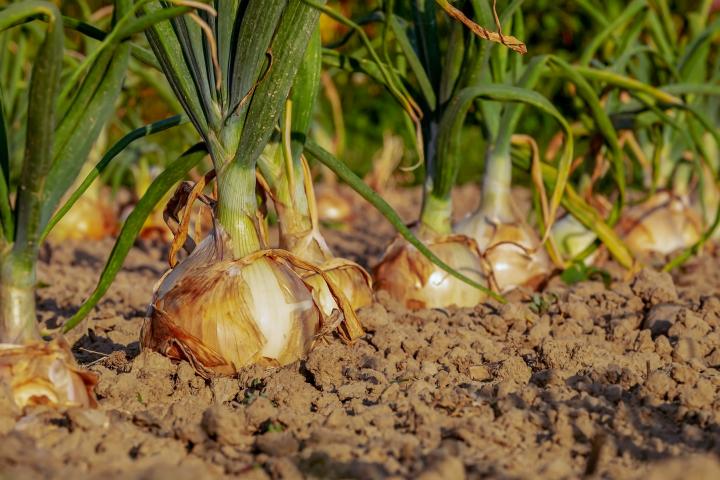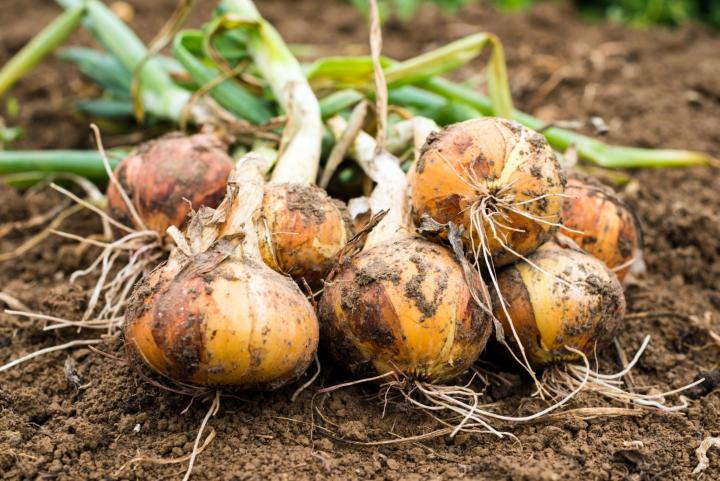Onions are a cold-season fall or spring crop, easy to grow because of their hardiness. Whether you start your onions from seed, sets, or seedlings, there are some tricks of the trade that make the difference between a great crop and a disappointing one. We’ll show you how to grow onions so perfect they could make you weep!
Onions can be planted in either the spring or fall. Onion plants grow well in raised beds or raised rows at least 4 inches high. Onions also can be grown in containers. We usually plant a mix of white, yellow, and red onions.
Should I Grow Onions from Seed or from Sets?
We prefer planting onion sets over starting them from seeds, simply because the sets establish quickly and are easier to plant. Onion sets are small onion bulbs that are sold specifically for gardening. Once planted, they develop into a full-size bulb after about 3½ months.
Also, onion sets can be planted without worry of frost damage, and they have a higher success rate than planting from onion seeds or transplants.
Of course, starting onions from seed is certainly doable, and may even be necessary in colder regions (Zone 5 and colder). If you’d prefer to try this method, check out our tips for growing onions from seed indoors.
When to Plant Onions
- Onions can be planted in both the spring and fall. Generally speaking, plant onion sets outdoors when the weather is cool—not cold.
- A fall-planted crop of onions needs at least 4 to 6 weeks of warm temperatures to become established in the ground. They will remain dormant during the cool season, but be all primed and ready to grow when spring arrives.
- In regions with a frigid winter, be sure to plants onion sets in the spring as soon as the ground can be worked—usually in March or April. Ideally, time your planting so that outdoor temperatures no longer dip below 28°F (-2°C) after the onions are in the ground.
- Fall-planted onions are a great way to enjoy an earlier and larger bulbed harvest from next year’s garden. Plant in the warm autumn soil so that they may establish a strong root system before winter sets in. As the cold chill of winter arrives, the crop goes dormant. Then, as the temperatures and soil warm again in early spring, the onions come back to life.
- If starting onions from seeds, start them indoors about 6 weeks before you plan to transplant them to the garden. Onion seeds need temperatures of at least 50°F (10°C) to germinate properly.
Preparing the Planting Site
- Growing great onions, whether in the spring or fall, all starts with soil that is well-drained, loose, and fertile. Compacted, rocky, or clay-heavy soil will affect bulb development.
- Tip: If you live in an area with heavy clay or hard soil, add in aged compost (humus) to improve soil texture. Read more about preparing the soil.
- Add aged manure or compost to the soil in the fall or early spring. Onion plants are heavy feeders and need constant nourishment to produce big bulbs.
- Select a location with full sun, where your onions won’t be shaded by other plants. The more energy they can get from the sunlight, the larger their bulbs can grow.
- At planting time, add about an inch of compost to the bottom of each row before planting. Or, dig a trench in the soil about 2 inches deep and 3 inches wide, and then fill the trench back in with about an inch of compost.
- Practice crop rotation with onions. In other words, don’t plant them in the same location year after year, as this can encourage the spread of diseases that affect the crop. Learn more about crop rotation.

How to Plant Onion Sets
- Choose onion sets that are around ¾-inch in diameter and no bigger. Larger ones may produce stiff necks and go to seed too quickly.
- When planting onion sets, plant them between 2 and 6 inches apart.
- When planting larger transplants into the garden, space plants 4 to 5 inches apart in rows 12 to 18 inches apart.
- Set the bulbs with the point end up and don’t bury them more than 1 inch under the soil. It’s important that onions aren’t planted too deep, as this can affect bulb development.
- Find more tips for planting onions in different regions and soils.

How to Care for Onions
Think of onions as a leaf crop, not a root crop (such as beets or carrots)!
- Fertilize every few weeks with nitrogen to get big bulbs. Cease fertilizing when the onions push the soil away and the bulbing process has started. Do not put the soil back around the onions; the bulb needs to emerge above the soil.
- Once bulbs have started to develop, mulch with a light ½-inch layer of straw (shredded leaves work well in the fall, too). Mulch will help retain moisture, suppress weeds, and allow air circulation.
- Generally, onion plants do not need supplemental watering if mulch is used. About one inch of water per square foot per week (including rain water) is sufficient. If you want sweeter onions, water more.
- Onions will look healthy even if they are bone dry, so be sure to water during drought conditions. This helps to prevent onions from bolting, which is when a stressed plant speeds up its development of flowers.
See our video demo to see how to plant and grow perfect onions!
- Thrips: To control thrips—tiny insects about as fat as a sewing needle—take a dark piece of paper into the garden and knock the onion tops against it; if thrips are present, you will spot their tan-colored bodies on the paper. A couple of treatments with insecticidal soap kills them. Follow the package directions. Spray the plants twice, three days apart, and the thrips should disappear.
- Onion Maggots: Cover your emerging onion crop with a fine mesh netting. Seal it by mounding soil around the edges. The onion maggot likes to lay its eggs at the base of plants, so the netting should prevent that. You should also keep mulch away because the insects like decaying organic matter, and make sure you completely harvest your onions as the season progresses. Onion maggots are usually a problem in very rainy periods, so these precautions may be unnecessary if you have a dry season.
Onions are sensitive to daylength, so varieties are generally classified into three categories: Long-day, short-day, and day-neutral. The border between long- and short-day varieties lies roughly at 36 degrees north latitude (aka, the 36th parallel)—north of this line, plant long-day varieties; south of it, plant short-day varieties. Day-neutral varieties can be grown with success anywhere!
Long-day Varieties
- ‘Yellow Sweet Spanish’: large, round shape; yellow-white.
- ‘First Edition’: high-yielding, stores well, flavorful, creamy-yellow
- ‘Red Wethersfield’: flat bulbs that store well, white flesh, red-skinned
- ‘Aisa Craig’, ‘Walla Walla’: huge bulbs
- ‘Buffalo’, ‘Norstar’: produce crops quickly, but don’t keep very long after harvesting
- ‘Copra’, ‘Southport Red Globe’, ‘Sweet Sandwich’, ‘Yellow Globe’: store very well
- ‘Red Florence’: produce bulbs with an oblong shape
Short-day Varieties
- ‘Stuttgarter’: sold in sets, early maturity with slightly flat shape, yellow
- ‘White Bermuda’: extremely mild, with thick, flat bulbs; white
- ‘Red Burgundy’: good table onion with mild, sweet white flesh, red-skinned
- ‘Crystal Wax White Bermuda’: a great onion for pickling when harvested at “pearl” size
- ‘Hybrid Yellow Granex’: sweet, Vidalia type
- ‘Southern Belle’: ruby-color flesh and skin
- ‘Texas 1015-Y Supersweet’: stores very well
Day-Neutral Varieties
- ‘Candy’: golden, thick flesh; jumbo bulbs; stores well
- ‘Red Stockton’: large, red-ringed, white-flesh bulbs
- ‘Super Star’: large, sweet, white bulbs
How to Harvest Onions
- Spring-planted onions tend to be ready for harvesting by mid-summer.
- Pull any onions that send up flower stalks; this means that the bulbs have stopped growing. These onions will not store well, but can be used in recipes within a few days.
- When onions start to mature, the tops (foliage) become yellow and begin to fall over. At that point, bend the tops down or even stomp on the foliage to speed the final ripening process.
- Loosen soil around the bulbs to encourage drying.
- Be sure to harvest mature onions by late summer, and do so in dry conditions. Onions harvested when wet do not cure well and may rot in storage. Mature onions may spoil in cool fall weather.
- When tops are brown, pull the onions. Handle them carefully, as the slightest bruise can encourage rot.

Photo by Rootstocks/Getty Images
How to Store Onions
- Clip the roots and cut the tops back to 1 or 2 inches (but leave the tops on if you are planning to braid the onions together).
- Let the onions cure on dry ground for a few days, weather permitting, or in a protected place such as a garage or barn.
- Once cured, hang onions in a mesh bag or nylon stocking, layer them (up to two layers) in a box, or braid and hang them in a cool, dry, well-ventilated area. The ideal temperature range for storage is 40 to 60°F (4 to 15°C). Do not store in a refrigerator, as conditions will be too damp.
- Check periodically for sprouting or rotting onions and remove them.
- Don’t store onions with apples or pears, as the ethylene gas produced by the fruits will interrupt the onions’ dormancy. Onions may also spoil the flavor of these fruits (as well as potatoes).
- A pungent onion will store longer than a sweet onion. Eat the sweet varieties first and save the more pungent onions for later.
Check out this video to learn how to harvest and store onions.
Can You Plant a Sprouted Onion?
Yes, you can plant a sprouted onion, though you won’t get more onions from it. You will get lots of tasty green sprouts, however! Here’s how to do it:
- Fill a pot with potting soil and make a hole in the middle that is about the depth and width of the onion.
- Place the onion in the hole and cover with soil.
- Water and put the pot in a sunny spot.
- Harvest the green sprouts as needed for cooking.
If you get a sprout with a flower, wait until the flower goes to seed. Save the seeds for planting in the spring.
Onion Cures and Home Remedies
- In the Middle Ages, it was believed that onion juice could cure baldness, snakebite, and headaches.
- A generation or two ago, children were treated with a poultice of mashed onions applied as a paste to cover a wound.
- A whole onion eaten at bedtime was prescribed to break a cold by morning, and sliced onions were placed on the soles of the feet to draw out fever.
- Early settlers made a cough syrup by steeping raw onion slices in honey overnight.
- A raw onion rubbed on a bee sting or insect bite will relieve the pain and itching.
Onion Weather Folklore
Onion’s skin very thin,
Mild winter coming in;
Onion’s skin thick and tough,
Coming winter cold and rough.
To make onions taste milder, soak them in milk or pour boiling water over the slices and let stand for 20 minutes. Rinse with cold water.
Chopping onions can sometimes look like a daunting task: There’s the skin, and the layers… Where to begin? Check out our tips for chopping onions in four easy steps. Onion skins actually have several health benefits, too, so don’t throw them out!
For more tips on using onions in the kitchen and cooking them correctly, click here.




